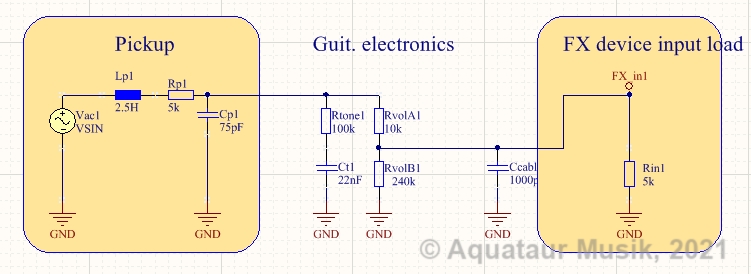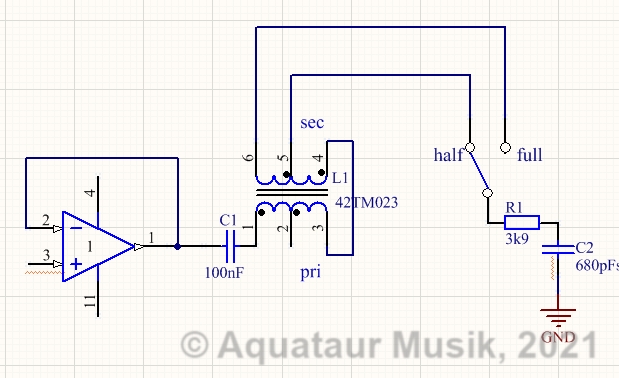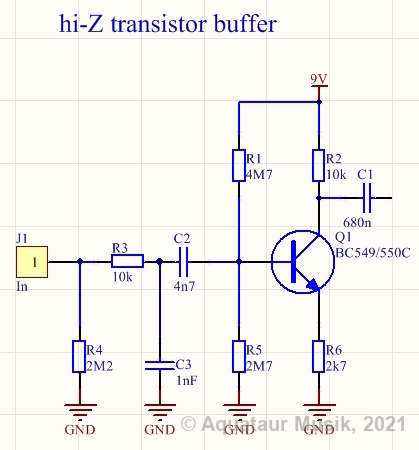| Pickup
Simulation With An
Audio Transformer Is It Necessary For Driving A Fuzz Face With A Buffer? last update: May 19, 2024 Copyright
2021-25 by H. Gragger. All Rights Reserved. All
information provided herein is destined for
educational and D.I.Y. purposes only. Commercial
re-sale, distribution or usage of artwork
without explicit written permission of the
author is strictly prohibited. The original
units with their associated
trade-names are subject to the copyright of the
individual copyright owner. The Author is by no
means affiliated with any of those companies.
References to trade names are made for
educational purposes only. By reading the
information provided here you agree to the Terms
of
Use. The working language
is kept in English as an aid. Read here
why.
|
||||||||
| MAIN PAGE>MUSIC STUFF>PICKUP_SIM Index     A
Good Idea To Restore Frequency Balance And Why
Itīs Flawed A
Good Idea To Restore Frequency Balance And Why
Itīs Flawed  Introduction The fuzz faceīs (hereafter: FF) notoriously low input impedance (around 8kOhm) leads to all sorts of problems due to impedance mismatch. Unfortunately, using a buffer without further thinking alters the FFīs tone. There are several attempts trying to cure this, and this article is an step towards a practical solution. Ideally, we want a subcircuit that emulates the sound of a FF connected directly to the guitar, which is in many peopleīs opinion the way god wanted it. Using a buffer does indeed change your faceīs tone - for the better. Back To Index The Guitar Pickup And Its Interactions First, letīs have a look at the guitar pickup. The interaction of internal pickup parameters with load, particularly capacity and FX device load, determines if the resulting tone is brittle (buffer without voicing), obnoxious (high peaking), dull (heavy load), pleasant (ideal load and voicing), or anything in between. High and untamed Qīs translate to high peaking, which almost always is perceived as unpleasant. Letīs look how all that impacts tone. Guitar > tube amp A commercial guitar will most certainly be voiced in a way that it sounds pleasant into the average userīs sound chain, which includes a tamed resonance. A behaved system therefore does not exhibit much ringing.
Now we are speaking of a behaved load too, but a FF does not belong to this category. Itīs input impedance is very low, around 8kOhm. At full volume setting (we are speaking of the guitarīs volume control), this load will be in parallel to the pickup, which will inevitably flatten any existing resonance. After even a small deviation from maximum position, the volume potīs series resistance (in the picture above called RvolA1) will take over and together with any alleged load capacitance flatten all ringing stone dead. The total circuit will thus appear as a smooth second order rolloff filter with no peaking.
Guitar >
close buffer > fuzz face
But you must not add any capacitance after the volume pot, since this will throw us back to scratch. It has to be added before. Up till now we have only talked about the pickupīs side. What about the FFīs side? A FF essentially has a current driven input. Use Logic, Watson. Such low impedance draws current. What has a pickup to impede this? A typical Strat pickup, 6-8k. And guess, yes, if the FF is driven hard (low impedance) it will sound driven hard. Back To Index A Good Idea To Restore Frequency Balance And Why Itīs Flawed This observation lead to the impression, that the FF sounds unnatural, because of driving it through a buffer with a simple series resistor to fake internal impedance.
This lead to the advent of the following circuit, which indeed simulates a pickup:
But
the idea is severely flawed for several
reasons:
You eliminated the expected frequency behavior by inserting a buffer without understanding what it does. If you then try to restore it with a similar circuit, the cat bites its own tail. Back To Index The Simplest Of All Solutions The good news is, treble can be controlled by the guitarīs tone control, which eliminates peaking too for the majority of its travel. If felt necessary, an additional filter cap after the 10k driving resistor yielding a 3kHz rolloff (about the frequency range of a well voiced strat pickup) would suffice. If you consider all this, a 10k drive impedance will work fine - the original frequency content is still there. This is, where the flaw is in the above thesis. So, lets sum this up:
Now you
will invariably ask: "why
do I need another buffer
on the input? I already
have a buffer at the
guitar." Any input buffer will serve for this current drive mechanism, be it discrete or integrated. A voltage follower of any sort just needs a 10k series resistance, a discrete amplifier may use a 10k collector (resp. drain) drive. The
input impedance should be in
the 1M region. Besides all that superfluous rigmarole, practical experience proved that the transformer is susceptible to hum intrusion. However, this can be remedied by a 90° flip of the casing or the hum source. So I will not likely use this circuit in a future build. Fortunately, even on an existing board, the whole arrangement is easily replaced by a 10k resistor or something in that range. From now on, you will look differently at that humble resistor.
Back To Index [1] AMZfx: (Jack Orman) Guitar Pickup Simulation, http://www.muzique.com/lab/pickups.htm [2] AIONFX: Solaris Germanium Fuzz building documents, https://aionfx.com/project/solaris-germanium-fuzz/ and others like the Proteus. Also see EQD eruptor (clone: PCB Mania Volcano device) [3] Stack Exchange, How do I use a transformer as an inductor? https://electronics.stackexchange.com/questions/33860/how-do-i-use-a-transformer-as-an-inductor Back To Index Update History
MAIN PAGE>MUSIC STUFF>PICKUP_SIM |
||||||||
MAIN PAGE | MUSIC STUFF | IMPRESSUM  (c) 2021-25 AQUATAUR Musik & Elektronik |




